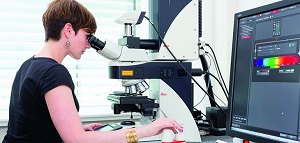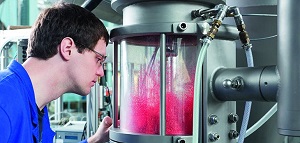It’s All in the Mix!
Of course it is assumed that each tablet in a package has the same composition and therefore the same effect. In powder detergent, the enzyme layer should on each granule should enfold to its full effect. The farmer expects that the individual active ingredients are present in the correct and always exact same composition in pellets of fertilizer and pesticides. And cocoa powder that covers us with brown dust instead of being easily stirred in, wouldn't budge from the store shelves.
Powder, granule, and pellet manufacturers are in principle interested in production methods, that satisfy the demands of their customer. The realization of these demands is also a scientific challenge. The abbreviation NaWiTec stands for the Junior Research Group for Fluidized Bed Technology at the University of Magdeburg’s Faculty of Process and Systems Engineering.
The association of young scientists explores, for example, how, in a fluidized bed process, granules and powders from liquid starting materials can be manufactured with the specific requirements to particle structure and properties. The method is applied in sectors, where products are usually composed of multiple active ingredients.


The Magdeburg scientists are able to use one of the largest and most advanced testing facilities worldwide for their research. Its construction was enabled by a network of regional business partners. These local companies also sponsored a professorship, which is aimed at exploring the formulation of high quality particles while saving energy.
The young scientist Andreas Bück holds this sponsored professorship. The Magdeburg native studied Systems Engineering and Technical Cybernetics at the University of Magdeburg until 2008. The control systems engineer with a doctorate describes researching in the complex and business-relevant field of fluidized bed technology as a “real stroke of good luck.” “The pharmaceutical industry, the food industry, and agriculture have high quality requirements and guidelines in place in terms of manufacturing and use of products,” says Bück. “If, for example, a pill is supposed to have multiple layers with differing pharmaceutical active ingredients, then the surface structure - compact or porous - of the pill must be clarified, since this determines its properties. The question of how thick the layers of active ingredients must be, is important. The question of under which conditions every single layer is supposed to dissolve, too. Our job is then to provide the industry with solutions on how to manufacture these layers.”
A newly developed probe intends to measure particles during the fluidized bed process. Inline-measurements have the advantage that action can be taken immediately if something isn’t running smoothly. “If particles don’t remain round during their formulation and form lumps instead, the new probe would signal that the moisture content is too high before the whole plant gets gummed up,” Andreas Bück explains. Sometimes lumps - technical term “agglomerates” - are explicitly desired, for example in cocoa powder. Without agglomeration it would remain a very fine powder and would hardly be able to be made into a drink.
Energy efficiency is another research focus. If the production requires a lot of energy then the product will be very expensive in the end, which does not exactly further its chances in the market. Up until now evaporation, which plays a large role in the fluidized bed process, has carried too high of an energy demand. The carrier liquid, usually water, is evaporated by heated gas mass flows that are passed through the evaporation apparatus. Being of no further use, the hot air is then discharged. It is lost, which displays a poor relationship to the expenditure of energy required for the production and movement of the hot air.
Together with business partners, the researchers at the Otto von Guericke University Magdeburg are searching for new methods to reduce the energy requirement during the formulation and heating of the particles. They want to develop possible strategies for heat recovery and show where the recovered energy can be used in the processes upstream and downstream from the evaporation. “We are following two paths,” Andreas Bück explains. “On the one side there is a column with a coil. It generates an induction field, in which hollow metal balls heat up. These float between the particles, drying them. Another energy-saving method so far resulted in showing that just by running the granulation process differently - namely separating the spraying and drying processes from one another - up to 20 percent energy can be saved without sacrificing product quality.